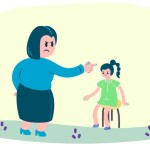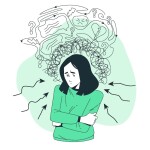Dysgraphia is an ignorance often accompanied by a vast disparity in inability to write intelligible words with a pencil. Surely, this condition is known to be complex and leads to further damage in almost every part of a person's life. Ironically, this is one of the most common but overlooked conditions, as many take it to be a sort of roadblock on the way to better perception and productivity.
In this blog post, we're going to discuss dysgraphia at length about dysgraphia: what it is, its symptoms, causes, and treatment options.
Dysgraphia is a much more complex condition, far beyond poor handwriting. It is actually a neurological disorder that impairs the writing part of the brain and language processes. A child struggling with this condition will have a rough time writing legibly, spelling correctly, and organizing his or her thoughts to present them in a coherent manner. A child can be born to any family, at any age, with any level of intelligence, and can be affected by this condition, ultimately affecting self-esteem, confidence, and general well-being.
Dysgraphia is not limited to academic struggles for many of its victims; rather, this condition impacts individuals on a personal and occupational level, including difficulties with clear communication, undue amounts of written work, and a gradual lagging behind their peers. The better you know the subtleties of dysgraphia and make an effort to offer support and accommodations, the easier it will be to overcome problems relating to that and help them to the best extent of their capabilities.
Symptom-Causes Solutions Introduction Dysgraphia is a writing disability. It is an inability or difficulty in writing because of psychological or neurological challenges within the brain. In this guide, we shall discuss the symptoms and causes of dysgraphia alongside strategies for coping with the condition. The article shall also cover the significance of early intervention, accommodations in education and the workplace, and the role of therapy and counseling in helping individuals with dysgraphia to manage their symptoms and develop effective coping strategies.
What is Dysgraphia?
Dysgraphia is a neurological disorder that affects the way a person writes with respect to handwriting, spelling, grammar, thought organization, and motor control. Dysgraphia may cause problems involving:
Handwriting: Handwriting that is not legible, with either inconsistent size or spacing of letters, or even an inability to form letters.
Spelling and Grammar: Spelling and/or grammatical mistakes at times due to difficulty in what is called visual-spatial processing.
Thought Organization: A lack of planning, sequencing, and expression when writing, which manifests as poor coherence or even incoherence when writing.
Motor Coordination: Fine motor ability or dexterity that would enable a child to use a pen or pencil or fingers to write might be impacted.
Causes and Contributing Factors
Although the cause of dysgraphia is still poorly understood, researchers agree that it might be genetic, neurological, or environmental. Indeed, people with dysgraphia also often have another debilitating disability, such as dyslexia or ADHD, and even cases of dysgraphia without other disabilities can be seen in problems related to areas of the brain that control movement, language, and visual-spatial skills.
Problems Individuals with Dysgraphia Experience
This condition can cause severe problems in school and out of school for people of all ages. For students in an educational environment, dysgraphia may impede work involving written assignments that leads to frustration, anxiety, and avoidance behaviors. People with dysgraphia in a professional context may experience some hurdles because dysgraphia causes difficulties in communication through a lot of writing.
Overcoming Dysgraphia
Despite these challenges, there are strategies and accommodations available that help individuals cope with the resulting difficulties:
Assistive Technology: Speech-to-text software, type-to-write programs, and other assistive technologies can aid in writing tasks and increase productivity.
Specific Instruction: Occupational therapy, as well as individualized educational support, can help the child develop fine motor ability and dexterity in hands to enhance handwriting.
Organizational Aids: Graphic organizers, outlines, and structured formats enable better organization of thought processes and coherence.
Practice and Patience: Sustained practice and an encouraging environment can help the individual with dysgraphia by improving writing skills over time.
Practicing Mindfulness and Relaxation: Stress management practices will help the person cope with the emotional trauma of dysgraphia
Peer Support Groups: Interaction with the people having dysgraphia may help them to feel some sense of belonging and community
Setting Up an Aiding Environment
It is the environment that distinguishes a normal human being from a disabled one. A supporting environment would be exactly what would make all the difference in case of a person suffering from dysgraphia. Teachers, parents, and even peers should know his needs and set up special places for him. In case proper support and accommodation are set up, people can defeat challenges posed by their dysgraphia and perform satisfactorily.
Relieving stigma and generating greater awareness
The whole case of dysgraphia is perceived in a wrong and stigmatized manner. It demands an understanding of this condition besides evil stereotypes. It might be only ensured when understanding and acceptance are encouraged, therefore assisting those with dysgraphia in feeling more empowered.
Other Considerations
Early Intervention: The early identification and cure of dysgraphia might enable people to develop tactics for dealing with their challenges.
Accommodations in School: Accommodations may also be provided in school by offering additional time to complete the work for the children having dysgraphia or properly using assistive technology.
Therapy and Counseling: Therapy will help a person who undergoes dysgraphia deal with the emotional issues that are caused by this disorder and build strategies about how to control the symptoms better.
Self-advocacy: Counsel the patient of dysgraphia to self-advocate for himself and the needs he may need to overcome problems and the resources that he needs.
Adjustments at work: This is where there may be a call for adjustments within the workplace, such as letting the hours of work become flexible or providing some form of assistive technology.
Support from the community: A chance to have access to local organizations or support groups that will give individuals with dysgraphia and their families access to resources and a community.
Personalized Learning Plans: Personalized learning plans that acknowledge the unique needs and strengths that an individual with dysgraphia encompasses could make academic settings more successfully navigated by an individual.
Positive reinforcement: Such an individual will get chances for positive reinforcement, and a motivational response will enable him to work on writing with confidence and interest.
Divide Large Tasks into Smaller Steps: The division of a large writing task into smaller, easy-to-manage steps could make the task less anxiety-provoking and would allow the individual to spend more time on a text.
Use of Multi-sensory Approaches: The use of multi-sensory approaches in learning would include visual aids, auditory cues, and kinesthetic activities as methods for efficient learning and retention of information by individuals who suffer from dysgraphia.
Technology Integration: Writing tools that incorporate artificial intelligence into them, which enables the tool to produce text, would be beneficial for a dysgraphic.
Environmental Factors: Making the environment more favorable for writing, such as ensuring that the furniture is designed to be ergonomic and there is enough light, would work for an individual who has dysgraphia.
Engagement in all such activities that promote self-care, including good food, exercise, and proper rest, decreases well-being and fights against stress.
Awareness: Making people aware of dysgraphia later and fighting for their rights makes a very sympathetic and inclusive society.
Because knowledge of dysgraphia and proper strategies could be used as weapons in overcoming adversity, it leads to a richer and more fulfilling life. Acceptance, understanding, and empowerment of a child with dysgraphia need a supportive environment.
Solh understands. Here are a variety of ways that Solh can be a self-investment feature.
It sometimes becomes too demanding for you because you lack a proper understanding of yourself. The feature to journal in Solh will help you get back to yourself and analyze your ideas or feelings inside a safe zone. Reflecting over your experiences and desires may help clarify what prevents you from self-care.
Anonymous Support Groups: You are not alone. Solh's anonymous support groups connect you with people who have experienced the struggle, thereby providing a listening ear, sharing experiences, giving comfort, and eventually finding a new perspective over the hurdle that will help you to indulge in self-care.
Solh Buddy: Feeling lost or disconnected? Your Solh Buddy, a personalized virtual companion, is here to provide encouragement and support along the way. It can offer prompts, celebrate your victories, and remind you of your strengths as you navigate this journey toward self-care.
Talk now: Sometimes, self-care can get really overwhelming. Solh's talk now connects you with dedicated counselors to help navigate such instances.
Solh believes that this is a different way of introducing self-care. What we give you are tools to empower you and protect your well-being. Discover the power of reflection, connection, and support for any problem in your mind through Solh today. You're certainly not alone on this path.








